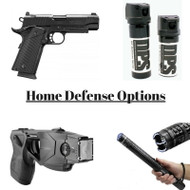Home Prep: Building Better Self-Defense into Your Home Security
Posted by Ralph Goodman on 1st Jan 2018

Home Prep: Building Better Self-Defense into Your Home Security
The necessity of self-defense does not end when you cross the threshold of your home. You never want to an easy target for crime, especially in your own home. Whether it is a home invasion or someone close to you who has gotten out of control, you must know how to prepare your home to improve your self-defense.

What Can Use In Your House?
There are many reasons that guns are a poor choice for self-defense, but when it comes to protecting yourself inside a home, there are even more issues. It is not a question of whether a shotgun might have a better spread, requiring less precision than a handgun or rifle. Every type of gun has the issue of wall penetration. This means that missing can be fatal for people that are not even in the room.
If you are looking for range, a taser gun is a better choice than a firearm because when you have children in the house, live with roommates, shooting through a wall is deadly. You also have to think about how disorienting a muzzle flash can be in darkness as well as the confusion that can be caused by the echoing boom of a shot in the home.
The dangers in your home might also be people you know: people who might get out of control, but whom you are not prepared to use lethal force against. Keep the personal protection devices in your home non-lethal.

Storing Self Defense Products
The type of self-defense products that you carry with you every day are likely what you want to reach for when you are responding to a home invasion or someone attempting to enter your home. With that being said, you do not want to have to remember where you put your pepper spray when you get home, or think about whether you left your stun gun in your car. You should have a dedicated defensive item stored in a permanent location within your home.
The storage location should always be the area in the home you spend the most time in. A home break-in does not always happen at night. In fact, most break-ins occur in the daylight hours. You might also be defending yourself from someone you know who is already in the home. For that reason, it is a good idea to store self-defense products in your bedroom or at a central point in the home that can be reached quickly no matter where you are in the home.
The most important thing about storage is that you do not keep your self-defense equipment under lock and key. Store it safely, but not in a safe. During an emergency where you must defend yourself, it is almost impossible to reliably use a combination or key. If you are trying to keep them out of the reach of children, obscure or conceal the location with a diversion safe.

Securing Your Perimeter
Make sure that your doors and windows are secure. You do not want a threat entering your home, but if a criminal is attempting to gain entry, better security will give you more time to react. If your security is strong enough, it might be able to keep someone outside until the authorities arrive.
The first thing that you want to do is secure your front door. This is the most likely point of entry for any break-in. Even if you don’t want to install a security door over your primary wood door, you can fend off kicking attacks by replacing your hinge screws and the set screws for your strike plate with 3-inch screws. This is a fast and cheap way to keep most criminals from just bursting in.
You should also invest in one of the best door locks so that your door does not compromise at the bored points. The holes cut in a door to accommodate locks should be filled with a lock that makes up for the missing material. Also, a high-security lock will prevent drilling, cutting, lock picking, and lock bumping attacks.

Creating Fallback Points
If someone gets inside or is inside already, you need a place in the home that you can retreat to. This should be a room with one point of entry. The room must have a high-security lock and a solid core door. This is uncommon for an interior door, so this prep is important. You can protect the door more by pre-installing the equipment needed for applying fast barricades (those that secure the door at the bottom work best).
Inside the room, you should have a cellphone that is fully charged. You can always leave it charging, as it should never leave the room. This can be an old phone with no payment plan, as you do not need a service provider for emergency calls. Just make sure that you do have reception.
Also be sure to store a taser or pepper spray so that you can defend yourself in the event that the improvised panic room should be compromised. Follow the same advice in the section above about “Storing Self Defense Products”.

| Guest Contributor: Ralph Goodman, Writer at United Locksmith |

 Menu
Menu
 Item(s)
Item(s)
